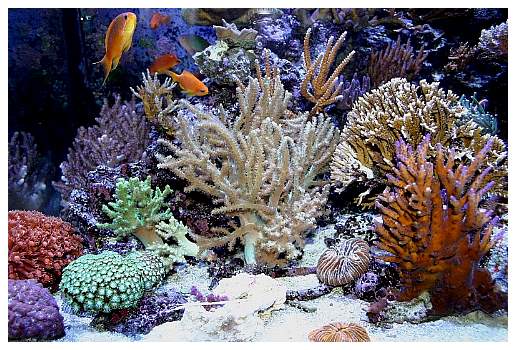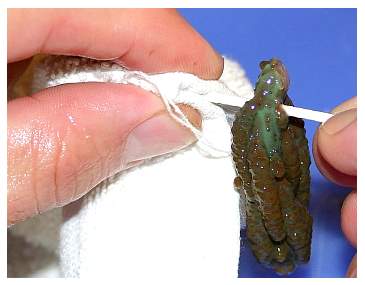|
Fragmenting a Green Tree Coral
Why Would You Want to Do It?
Some soft corals
grow very rapidly and, if unchecked, can begin to poison other
corals in the tank with allelopathic toxins. The toxins can
work systemically throughout the tank and can be reduced though
the use of activated carbon, but are particularly damaging
to adjacent corals. This photo shows why it is necessary to
use carbon and the importance of occasionally fragmenting
a coral. The Anacropora colony to the right of the
large tree coral in the center of the photo has already lost
a significant patch of live tissue from contact with the green
tree coral colony. The blue-tipped Acropora formosa
in the background also has some dead branches due to its proximity
to the green tree coral. Even part of the Alveopora
colony to the left of the green tree coral is partially retracted.
I've been propagating this species of green tree coral for
about seven years now, and it is particularly well suited
to propagation due to its fast healing, quick attachment and
growth, and its resistance to disease or infection. The colony
in this photo is likely by now a 10th to 15th
generation fragment.
 |
Get Your Tools Together
Some of the tools you will need for
this procedure are shown in the photo to the right. Most forms
of gel superglue work well. The serious fraggers can be identified
by the size of their superglue bottles! The plastic toothpicks
are available at most drugstores. Any plastic tooth picks
can be used. The commonly available ones shown in the photo
that I have found in my local drugstores have a "brush"
end on them for removing plaque more effectively from teeth;
this does not matter much for coral fragmentation purposes,
though. They even come in blue and pink in case you want to
spice up your "frags" a bit or you are certain of
the sex of your coral.
Hack up the Coral
If possible, it's best to remove the
coral from the tank so that any toxins that ooze out of the
cut tissue will not end up in the display tank's water. The
fragments can be cut free with a razor blade as shown, or
by using a sharp scissors. Because of the tissue crushing
that might occur, some corals can sustain more damage if a
scissors is used than if they are cut with a razor blade.
Depending upon where the cuts are made, and the nature of
the coral species you are cutting, you may need to cut with
a sawing motion to get through any of the sclerites (needle-like
calcium carbonate internal skeletal elements) you encounter.
These sclerites are more numerous toward the base of most
corals, and there is less tissue there. This proteinaceous
material is the living tissue that will grow and eventually
allow the coral to attach to a substrate. Depending upon the
coral, if too little tissue is present in the cut fragment,
the coral might not heal and attach properly. The size of
the fragment may also be important for propagation success.
Fragments smaller than two inches long may be difficult to
work with and less likely than larger fragments to heal and
grow quickly. Until you have experience fragmenting the particular
type of coral you are working with, it is best to err on the
side of cutting too large a fragment.
 |
The Toothpick Method
Using a rotating motion, pierce the
fragments using the toothpick's sharp end, about ½"
from the base of the stalk.
|
Left: piercing the coral near its base with a
toothpick. Right: multiple fragments ready to
be attached to a base. Multiple cuttings in such a small
container can foul quickly, so do not leave them there
for long.
|
Gluing the "Frags" Down
Small pieces of live rock or clean
dry rock can be used for mounting. Ideally, the rock should
have a small hole or depression that the live coral tissue
can protrude into, with good attachment points on either side
of the hole for the toothpick. The sections of the toothpick
extending from either side of the coral fragment are dried
before positioning, and the areas of the rock where the toothpick
will be attached must also be dry. If using live rock, quickly
drying just the section of rock where the toothpick will be
attached will allow most of the encrusting organisms on the
rock to survive. The glue can then be applied to the toothpick
or the fragment, and the fragment held in place until the
glue firms up a bit. It's important that when the gluing down
of the fragment is complete, the coral tissue should be just
lightly touching the substrate; keep in mind that the coral
tissue will likely expand when it is put back into the water.
If the tissue is forced against the substrate too hard, it
might promote poor healing or disintegration of tissue, possibly
by infection. It typically does not matter if the section
of tissue that is touching the substrate was the newly cut
section. But, strong water flow to cut areas facilitates healing
as they are not in contact with the non-native microbial flora
that are typically found on substrates.
 |
 |
Once the glue has set up a bit more (10-15 minutes) the fragments
can be returned to the tank. The best success rates are likely
to occur if the fragmented coral is returned to a tank with
conditions similar to those where it was grown. Increased
water flow may be important in some cases to help flush away
extra mucus and any microbial growths that might take advantage
of the damaged coral tissue.
|
The mother colony is clearly unhappy, but will recover
in a matter of days. The spotted goby seems to be questioning
the trim job.
|
Within a few weeks, the fragment will have attached. At this
point the toothpick can be removed if you like, or not. The
plastic will not degrade, and it typically does not cause
any problem imbedded in the coral tissue. The coral will continue
to grow, and may eventually encase the toothpick completely.
You can remove the toothpick with a rotating motion similar
to the way it was inserted. Some corals, though, will adhere
strongly to the toothpick, and removing the toothpick might
do considerable damage, or might pull the lightly attached
coral off the rock. Still other corals seem to "dislike"
the toothpick imbedded in their tissues and, while it does
not seem to be the source of infections, sometime the coral
will attempt to pull all of its tissue away from the toothpick.
By this time, however, the coral is usually attached to the
substrate and the toothpick is no longer required.
Some Final Notes
The toothpick method will work to
varying degrees for many different genera of corals - Sinularia,
Lemnalia, Nephthea, Capnella, Sarcophyton,
Cladiella and Lobophytum. It tends to work best
with corals that have a significant density of sclerites within
their tissue. Corals that are less supported by sclerites
and are "softer" (e.g., Klyxum or "Colt")
can sometimes "melt" away from the toothpick before
they have attached to the substrate.
Happy Fragging!
If you have any questions
about this article, please visit my author forum
on Reef Central.
|

